Spray painting tips for paper maché projects
Published by Manning on December 14th, 2018
Spray paint is a big part of my process for creating most of my paper maché masks and sculptures, and it can be a huge time-saver when you’re working on any large shape. Here are my tricks and tips for working with spray paint, whether you’re a beginner or a seasoned pro!
I use Montana Golden acrylic spray paint for all my commission projects and any of my more-serious personal projects like my Mardi Gras skull masks; it’s the best-quality spray paint I’ve worked with. I go through several cans of their shock black and shock white (paid links) every year, and tons of other colors depending on the project.
Note: The Montana spray paints that I use have a black plastic ring hidden under the nozzle; it looks like a washer. You have to lift off the nozzle and remove this ring before you can paint! If you don’t know about this, you might think you got a defective can, as it’s impossible to push the nozzle down when the ring is in there. Whenever I buy this stuff at the art store, as they’re ringing me up they always ask me if I’ve used this brand before, clearly because they’ve had tons of people bring back cans that they thought were defective. Anyway, the ring is there to prevent you from accidentally pushing on the nozzle and spraying paint everywhere when you don’t want to, like in your bag on the way from home from the store. I always remove the ring and throw it away; I suppose some people might keep it and put it back in there when they’re not using the paint.
By the way, the Montana brand spray paint doesn’t come with a lid; I guess the ring uses way less plastic than a lid, which is nice! If you buy a brand of spray paint that does have a lid on it, then it almost definitely doesn’t have this ring in there, since the lid will prevent you from pushing the nozzle down by accident.
Before painting: shake the can
This is obvious, right? You’ve gotta shake the spray paint can for a good two minutes or so before using it. In colder weather you might want to shake it even longer. I always overdo this just in case; couldn’t hurt! If you don’t shake the can well enough, the paint may come out in weird spurts and little blobs.
When you start shaking the can you might not feel the paint moving and you might not hear the bead rattling around inside; just keep at it!
If I’m working on a really serious project, I’ll always do a couple test sprays on something else (some newspaper or whatever) before painting my project — just to make sure the paint is coming out nice and even and not in clumps or spurts. If it’s not coming out nice and even, keep shaking! And if several minutes of shaking doesn’t help, then you might need to clean (or replace) the nozzle.
Spray painting technique
Before painting, you need to protect your work area, but that’s boring so I put that info at the bottom of this article! Let’s skip to spray painting!
When spray painting, you usually want to get the most even coat you can get without going overboard and getting drips. To avoid applying the paint too thick, you want to keep your hand moving while you’re painting. If I’m painting a large surface I usually move my hand quickly in little loops as I move along the surface, or quickly in a tight zigzagging line. You’ll get the hang of all this pretty quickly.
The distance you’re holding the spray paint can from your surface is important too; if your hand is too close it’ll cause drips, and if you’re too far you won’t get good solid coverage. Anywhere from 3″ to 6″ is probably good. The closer you’re holding the can to the surface, the faster you need to move to prevent drips!
Sometimes the first burst of paint seems to come out a little thicker/heavier than you’re expecting, so a technique I like to use is this: Rather than point the spray paint right at my surface, I point it a few inches away from it, then start spraying (at nothing), and then move my hand toward the surface and start painting. This gives you a little better control and lets you ease into painting.
If you see the paint starting to form drips on your surface, you’re spraying too close and/or moving too slow!
Multiple coats
If you’re doing multiple coats of spray paint, it’s important to wait a long time between coats. The paint might feel dry after 30-60 minutes, but it may not really be 100% set or cured. I recommend waiting at least six hours between coats, or even a full day if you have the time. If you apply multiple coats of spray paint too quickly, you risk getting a really ugly cracked pattern all over your surface. This is called crazing! I love that word! This happens as two coats of paint dry and set at different speeds. It’s important to make sure that first coat is 100% set to avoid this.
(The same risk is there when applying a finishing coat like matte spray; if you do that too soon after your last coat of spray paint, you risk getting the cracked pattern.)
The weather can be a factor in all this too; see more on weather below.
Masking out areas
I sometimes use newspaper along with painter’s tape (which is often blue, or sometimes white) to mask out an area and protect it from spray paint. A good example of this is the gold stripes on my Anubis mask:
For this mask, I spray painted the whole thing black, waited a day, and then I put the painter’s tape on in long lines. I protected the rest of the mask with newspaper, and then I spray painted gold over the area where the stripes are.
Here are a few things I’ve learned about this kind of work:
You need to be really sure that your first coat of paint is 100% dry and set before putting tape on it. I recommend waiting at least 24 hours. Earlier than that, the paint might feel dry to the touch, but then the tape peels the paint right off! Yikes!
When you apply the tape and then do the spray painting with the secondary color, it’s important to wait a long time before peeling the tape off. I’d say at least three hours. If you start peeling the tape when the paint isn’t 100% set, it’ll mess up the edges of your lines as a little bit of the second color tries to come off with the tape.
Note: Regular masking tape is too sticky for this kind of work! I’ve tried using it for some projects, and when I went to slowly peel it away, it peeled off the first coat of spray paint! This happened even if I waited plenty of time.
The kind of paper you use matters! I’ve tried masking out areas with tape and paper towels, rather than newspaper, since paper towels are softer and easier to fit onto irregular shapes. However, I found out that spray paint can go right though paper towels! They’re porous enough that the surface underneath got a light dusting of paint. Very surprising, and unfortunate! So watch out for that.
I find that it’s better to use at least two layers of newspaper when doing this kind of masking. If you use one layer of newspaper, it might become saturated with the paint and stick to your project. If you use two layers, it’s fine if the outer layer gets saturated; it will only get stuck to the second layer.
Weather
Extreme heat and extreme cold can have a big effect when you’re applying spray paint, and also on the drying/setting time. Obviously, extreme heat makes the paint easier to shake and mix up, and it’ll spray nice and smooth, and if the weather’s not too humid the heat can help it dry relatively fast. Extreme cold can make the paint much slower to mix — you can feel and hear the bead inside moving around more slowly at first. So it helps to shake it for a few extra minutes. And I’ve found that trying to use spray paint outside in freezing or near-freezing temperatures can be a big problem; the paint tends to come out with some big drips in it, which can really mess up your surface and create little bumps.
I often get stuck with no choice but to use spray paint outside in cold weather, so I’ve come up with a few things that help. The main thing is: I keep my paint, and the project I’m painting, inside my apartment for as long as possible, and then I bring everything outside and do the painting as quickly as possible. That way both the paint and the object are still somewhat warm while I’m painting.
Of course I leave the project outside after painting it. If I’m applying multiple coats, I’ll wait ’til it’s time for the next coat, then I’ll actually bring the project back inside for twenty minutes or so to warm it up (even if it really smells like chemicals), and then I’ll bring it and the paint cans back outside and quickly do the next coat.
Like I mentioned above, if you’re doing multiple coats in cold weather, you really need to wait a long time between coats; I’d recommend eight to ten hours, or even a full 24 if you have the time!
Wind can be really annoying when you’re trying to spray paint! It’ll push the spray away from the object you’re painting. I really try to avoid having to do any spray paint when it’s windy, but sometimes I don’t have any choice. In that case I walk around to the four corners of my terrace and try to gauge which corner feels the least windy; there’s usually one that’s not too bad, so I work there. I also try to make sure I’m painting in the direction that the wind is already going.
Creating a light dusting effect with spray paint
One slightly advanced trick I love to do is to use a light dusting of black or another dark color of spray paint to create shadows and/or dirty up surface. I use this on a lot of my Halloween decorations when I’m trying to make something look old and dirty and spooky. This technique is pretty easy but it can take a little trial and error. All you’ve gotta do is hold the spray paint can about 12″ from your surface, and move very quickly over it. You might see very little difference at first, but a few passes will start to make the effect work. Remember, you can always add more paint, but you can’t subtract!
Clearing the nozzle
When you’re done painting, it’s important to clear the nozzle, so the last bit of paint doesn’t stay in there and dry and then block the whole thing up. To do this, turn the can upside down and spray it for a couple seconds; you’ll see the spray starts out with the color of the paint but then turns clear. As soon as it’s clear, you’re good.
This technique isn’t possible with every brand of spray paint, but for higher-quality brands it should work. Some cheaper spray paints I’ve tried just spray the paint out forever, even upside down. In this case, there’s no way to clear the nozzle.
If the nozzle isn’t clear, the paint might spray out unevenly with big drops spurting onto your surface, or it might not work at all!
You can remove and clean the nozzle with paint thinner or even nail polish remover, but this is more hassle than I’m usually willing to deal with. I also find that this doesn’t always work really well; sometimes you just can’t save it. The older the can, the more likely this is.
You can also buy a set of new nozzles pretty cheap, if you feel like going to that much trouble! They even make different kinds of nozzles for different kinds of spray effects — like different spray widths, etc — but I haven’t delved into all that. The default nozzle shape/size is fine for all my projects.
Storage
I sort of covered this under weather, but of course you want to store your spray paint cans inside, not in a shed outside where they can get super hot or super cold. Since the Montana cans don’t have lids, I bought a big flat plastic storage container with a lid, so I can stand all the cans in that, close it up, and then stack more things on top. One time I had a open cardboard box full of Montana cans and I thoughtlessly stacked a few things on top of the exposed cans, and a few of the nozzles depressed! Luckily I caught it right away! A little bit of paint sprayed out, luckily into the box, and my living room smelled like spray paint for a couple hours; no big deal.
Protecting your work area
I live in a small apartment, but I’m lucky to have an outdoor terrace I can use for spray painting. I use a few different methods for preventing spray paint from spraying/dripping onto the concrete; I want my security deposit back!
If I know I’m going to be spray painting a lot of small projects over the course of several days/weeks, I’ll take two 30″ x 20″ sheets of foam board and tape them together to make a 40″ x 30″ board. I set this on my plastic patio table and work right on that; I try to be very careful to always angle the spray paint to only hit the foam board and not the table, and I’m careful to keep the can over the foam board while I’m working so it catches any drips.
The great thing about working with a board like this is that I can easily turn it with one hand as I’m painting. And when I’m done painting I can remove the board and set it aside against the building (wedged behind a chair so it doesn’t blow away), and I can come back to it every day to continue working.
If I’m only going to be working with spray paint for one afternoon, sometimes I tape tons of newspaper to my patio table and work on that. This is kind of a pain ’cause you need a lot of tape to keep all the edges and corners from flapping around in the breeze. You also need this covering to be multiple layers of paper thick; at least two or three, so drips don’t go through.
Another method is using a cheap shower curtain from the dollar store — you can tape this down on a table, or lay it on the ground (or in my case on the concrete) and weigh down all the corners and edges with heavy stuff; I usually use all the tools in my toolbox for this.
Letting the project air out
Most brands of spray paint will leave a strong chemical smell that takes a few days to go away. Depending on the brand of spray paint you use, the size of your project, and how many coats you apply, this could be as little as one day or as much as three or four.
I’ve definitely brought a project back in the apartment too soon, and a few minutes later I realize the whole place smells strongly of chemicals. So I’ve worked out different ways to let my projects air out outside. This can be a real challenge when it’s raining/snowing/windy!
If the project is heavy enough to not tip over or blow away in the wind, I’ll just set it under my patio table so it can’t get rained/snowed on, and I’ll drag everything over by the wall of the building where there’s less wind.
Unfortunately a lot of my projects are very lightweight and hollow, so even a light breeze will send them tumbling around my terrace! In this case, I use this large plastic storage container that we have on the terrace; basically a big trunk. Normally it holds the cushions for our patio furniture, but when I need to air out a big project for several days, I bring all the cushions inside, and I put my project in the container. It’s important to prop the lid open, but just a tiny amount, so air can get in and out but rain or snow can’t get in, even with heavy wind. I usually wedge something in there like a few pieces of cardboard stacked up, and then I tape the lid down so it’s just barely open. And you want to make sure to tape it down tight; if you don’t use enough tape, a good gust of wind can blow the whole thing open!
Depending on the season and the weather, dust and pollen can be an issue too. If you leave a project outside and totally exposed to the elements for a few days, dust and pollen may settle on it. If this happens during the first day after painting, the dust may get permanently glued onto your project! Leaving it in a mostly-closed box can definitely help avoid this problem, but you could take this one step further and tape some cardboard or newspaper around the opening of the box. Like, let’s say I’m working on a big skull mask; I might set the mask at the far end of the big storage container, and completely block that side of the opening with cardboard, but leave the 1/2″ gap open at the other end of the box, where dust is less likely to come in and settle on the mask. All that might be overkill, but I really think you can’t be too careful!
As I’ve mentioned in a few of my articles, if it’s a big mask I’m working on, I usually make stand for it out of a few wine bottles taped together. With a large and somewhat delicate mask, you don’t want to sit it down on a flat surface for a long time, because the weight of the thing might make the sides warp a bit. Setting it on a stand helps avoid this problem completely.
Related: matte spray, gloss spray, gesso spray
Along with spray paint, the other products I use that come in a spray can are Blair matte spray and gloss spray, and Krylon gesso spray. The rules and techniques for all of these are pretty much the same as for spray paint. Just like with spray paint, it’s very important to let any one coat set for a long time before applying the next one; otherwise you can get that crackle pattern (crazing).
All three of these take less time to air out and not smell gross; usually just a few hours.
That’s all I can think of for now! Happy painting!
Related: Once spray painting is done I have a whole bunch of other steps that I do for painting details and stuff; you can read about all of that here!




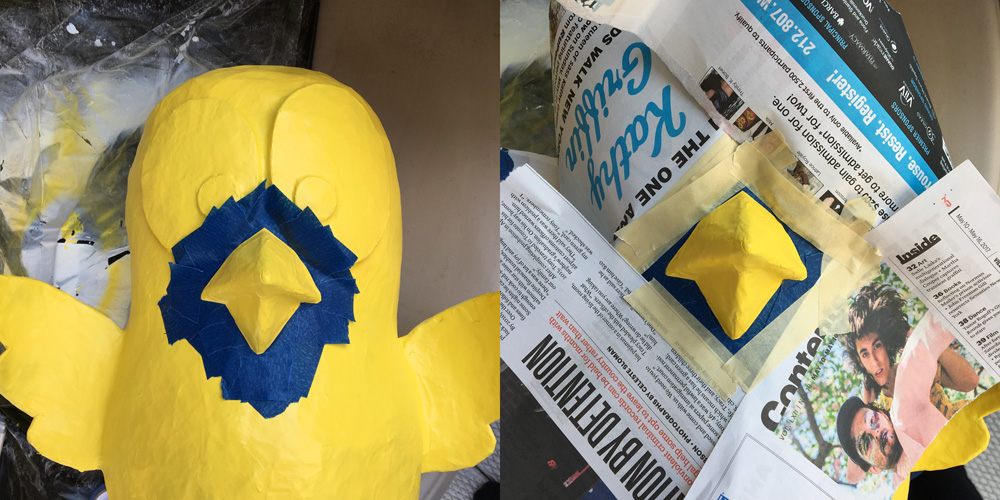
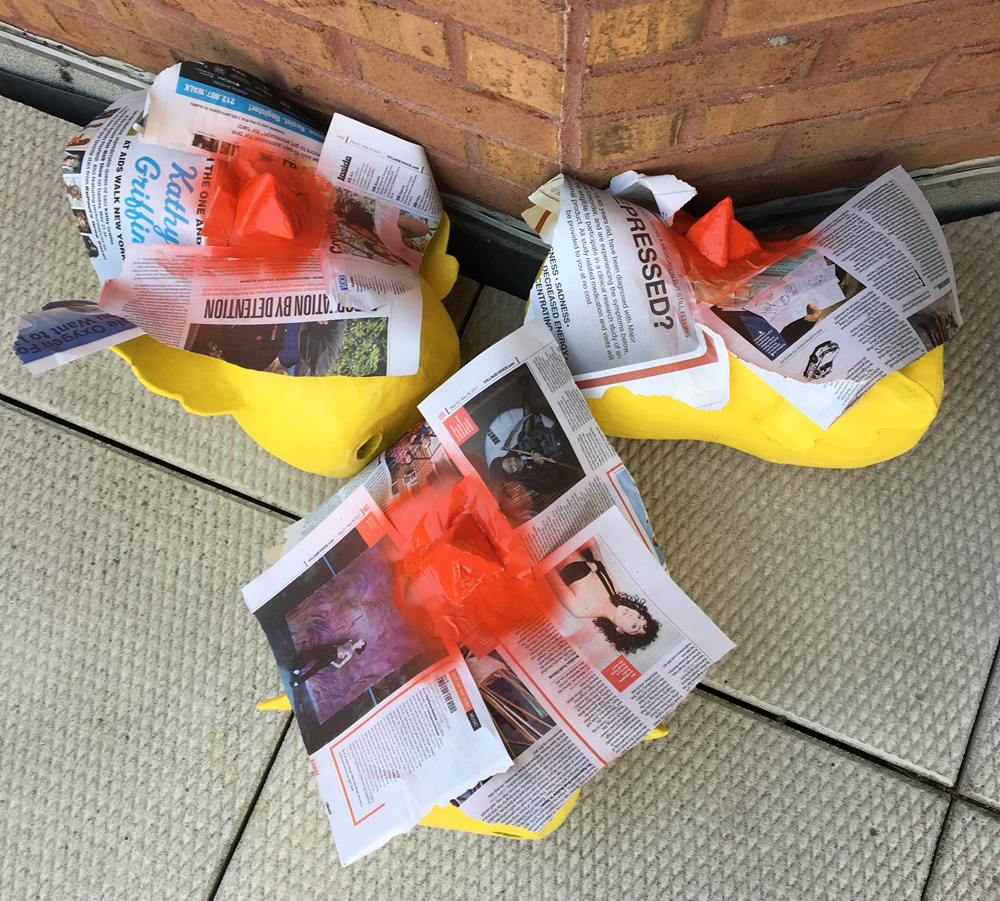

 About Manning Krull
About Manning Krull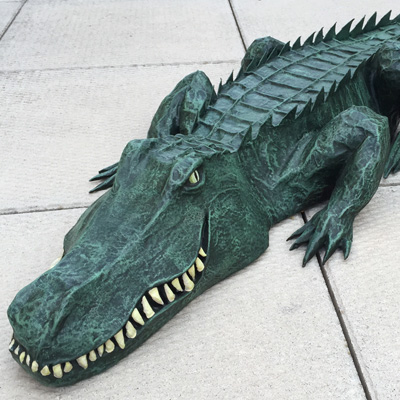 How to make a 4-foot paper maché alligator
How to make a 4-foot paper maché alligator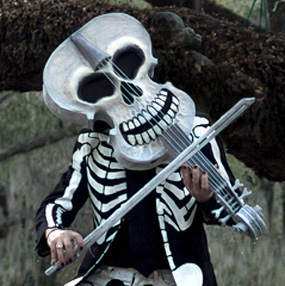 My violin skull mask, Mardi Gras 2015
My violin skull mask, Mardi Gras 2015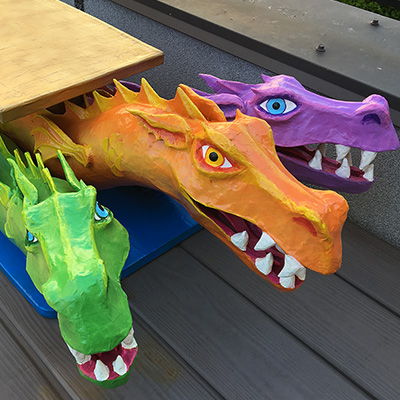 Three-headed paper maché dragon sculpture
Three-headed paper maché dragon sculpture
Leave a comment